Modeling the inhomogeneous response in transient shearing and extensional flows of entangled/micellar solutions
Presenter
October 13, 2009
Keywords:
- Inhomogeneous linear forms
MSC:
- 11J20
Abstract
Surfactant molecules (micelles) can self-assemble in solution
into long
flexible structures known as wormlike micelles. These
structures entangle,
forming a dense network and thus exhibit viscoelastic effects,
similar to
entangled polymer melts. In contrast to 'inert' polymeric
networks,
wormlike micelles continuously break and reform leading to an
additional
relaxation mechanism and the name 'living polymers.'
Experimental studies
show that, in shearing flows, wormlike micellar solutions
exhibit spatial
inhomogeneities, or shear bands. The VCM model, a two-species
elastic
network model was formulated to capture, in a self-consistent
manner, the
micellar breakage and reforming. This model consists of a
coupled set of
partial differential equations describing the breakage and
reforming of
two micellar species (a long species 'A' and a shorter species
‘B’) - in
addition to reptative and Rousian stress-relaxation mechanisms.
Transient
and steady-state calculations of the full inhomogeneous flow
field show
localized shear bands that grow linearly in spatial extent
across the gap
as the apparent shear rate is incremented.
This model also captures the non-monotonic variation in the
steady
state elongational viscosity that has been reported
experimentally and
the marked differences between the response of micellar
solutions in
biaxial and uniaxial extensional flows. The non-monotonic
variation in
the extensional viscosity has important dynamical consequences
in
transient elongational flows; In filament stretching
experiments
designed to measure the extensional rheology of wormlike
micelle
solutions, it has been observed that the elongating filaments
may
suddenly rupture near the axial mid-plane at high strain rates
[Rothstein]. This newly-observed failure mechanism is not
related to
the visco-capillary thinning observed in viscous Newtonian
fluids.
Results of time-dependent simulations with the model carried
out in a
slender filament formulation appropriate for elongational flows
of
complex fluids are presented. The simulations show that
elongating
filaments described by the VCM model exhibit a dramatic and
sudden
rupture event similar to that observed in experiments. This
instability is purely elastic in nature (i.e. it is not driven
by
capillarity) but arises from coupling between the evolution in
the
tensile stress and the number density of the entangled species.
The
dynamics of this localized necking are contrasted with
predictions of
other nonlinear viscoelastic models.
